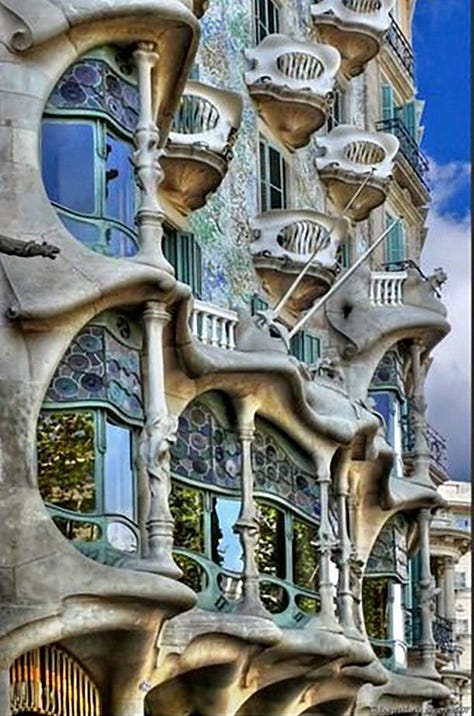14 designers, labeled and classified by those who didn’t share their intensity of focus
When holistic obsession with your work is THE REASON you are good at what you do
You may have heard the phrase:
“Anyone who tells you that you take your work too seriously has never worked a day in their life.”
Many designers feel this way about their work. I am one of them.
There is an intensity of focus that is contagious and goes along with working with the best designers on the planet. Designers who are so intentional at designing things that are thought through well enough that they themselves want to live inside of their creations.
An intensity so intense that any doctor would be blind not to be worried at how important some designers see their own work.
Here is list of other designers throughout time who have been classified and over-diagnosed during their lifetime by those who didn’t share their intensity of focus:
1. Charles Rennie Mackintosh



(1868–1928) - A Scottish architect, designer, and artist, Mackintosh’s work was influential on European design movements such as Art Nouveau and Secessionism. His meticulous attention to detail and periods of significant productivity contrasted with times of relative obscurity, hinting at the emotional highs and lows characteristic of bipolar disorder.
2. Frank Lloyd Wright (1867–1959)



An American architect, interior designer, writer, and educator, Wright designed more than 1,000 structures over a creative period of 70 years. Known for his intense dedication to his work and his turbulent personal life, Wright’s relentless pursuit of his architectural vision and his personal struggles have led to speculation about his mental health.
3. Edvard Munch (1863–1944)



Though primarily known as a painter, Munch’s work covered several mediums and is known for its emotional intensity and psychological themes. His famous work, “The Scream,” epitomizes his exploration of deep psychological distress. Munch himself suffered from anxiety and hallucinations, which have led some to consider the possibility of bipolar disorder.
4. Georgia O’Keeffe (1887–1986)



Renowned for her paintings of enlarged flowers, New York skyscrapers, and New Mexico landscapes, O’Keeffe’s work is celebrated for its bold innovation and vivid expression. Though less is known about her personal mental health, the intensity and focus of her work, along with periods of isolation, have intrigued some biographers.
5. Le Corbusier (1887–1965)



Charles-Édouard Jeanneret, known as Le Corbusier, was a Swiss-French architect, designer, painter, urban planner, and one of the pioneers of what is now called modern architecture. His approach to design and architecture was both innovative and controversial, marked by periods of intense productivity and creativity. His comprehensive theories and designs reflect a profound engagement with his work, which, for some, suggests the possibility of underlying bipolar traits.
6. Yayoi Kusama (born 1929)



A Japanese contemporary artist who works primarily in sculpture and installation but is also active in painting, performance, film, fashion, poetry, fiction, and other arts. Kusama has lived voluntarily in a psychiatric hospital since the 1970s and has openly discussed her struggles with hallucinations and obsessive thoughts, which she channels into her art. Her condition has been publicly discussed in terms of obsessive-compulsive disorder and possibly bipolar disorder, although direct references to bipolar specifically are speculative.
7. Alexander McQueen (1969–2010)



A British fashion designer and couturier known for his unorthodox designs and shock tactics. McQueen’s work was both admired and controversial, reflecting his deep engagement with his craft and his emotional struggles. His intense creativity and public discussions about his mental health struggles have led to posthumous speculation about his psychological state, including discussions around bipolar disorder.
8.Alvar Aalto (1898–1976)



A Finnish architect and designer, Aalto’s work is notable for its humanistic approach to modernism. He integrated natural materials and organic forms into his buildings and furniture designs, reflecting a deep connection to the natural world. His prolific output and dedication to his vision hint at a deeply passionate and focused mindset.
9. Antoni Gaudí (1852–1926)



A Spanish architect known for his highly individualized and one-of-a-kind style, Gaudí’s work was marked by his intense religious faith and love for nature. His masterpiece, the still-unfinished Sagrada Família, exemplifies his unparalleled creativity and the obsessive dedication he had towards his work, which could suggest an all-consuming focus.
10. Eileen Gray (1878–1976)



An Irish architect and furniture designer, Gray is known for her pioneering work in modernist design. Her meticulous attention to detail and the innovative use of materials in her furniture and architectural designs reflect a profound engagement with her craft, suggesting a singular focus and intensity.
11. Maya Lin (born 1959)



An American designer and sculptor, Lin came to prominence with her design for the Vietnam Veterans Memorial in Washington, D.C. Her approach to design, which integrates landscape and architecture, reflects a deep thoughtfulness and intensity. Lin’s work, characterized by its emotional depth and simplicity, suggests a powerful focus and dedication.
12. Isamu Noguchi (1904–1988)



A Japanese American artist and landscape architect, Noguchi’s work blended sculpture, architecture, and design. He created iconic modern furniture and large-scale public sculptures, reflecting a life dedicated to the exploration of form and space. His relentless pursuit of artistic expression across different mediums points to a deeply focused and creative mind.
13. Jean Prouvé (1901–1984)



A French metal worker, self-taught architect, and designer, Prouvé is known for his innovative approach to construction and furniture design, combining engineering and architecture. His work, characterized by its functionalism and simplicity, reflects an intense engagement with the materials and principles of design.
14. Saul Bass (1920–1996)



An American graphic designer and Oscar-winning filmmaker, Bass is best known for his design of film posters and motion picture title sequences. His iconic work for films like “Vertigo,” “Psycho,” and “The Man with the Golden Arm” revolutionized the visual presentation of cinema. Bass’s ability to distill complex themes into minimalist, evocative designs indicates a profound focus and understanding of visual communication.
It is not better to teach a child that flipping hamburger patties and working harder, not smarter holds more valuable lessons in life than to teach a child that you can exponentially improve upon the experiences other people are having in life by using your own brain and that their happiness is something they should prioritize.




